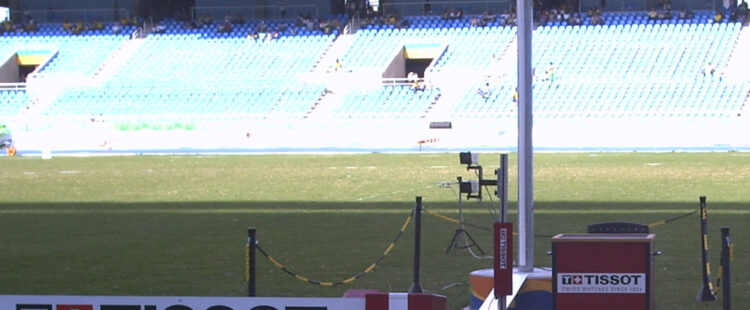Disclosure: I may earn affiliate revenue or commissions if you purchase products from links on my website. The prospect of compensation does not influence what I write about or how my posts are structured. The vast majority of articles on my website do not contain any affiliate links.
I really enjoyed running track in high school. I was never particularly good but I won some medals at the local level. Still following the sport pretty closely often leads me to exploring its nuances. Believe me, there are many.
I recently read a wild article from Scranton’s Times-Tribune where a runner cruised to a 4:27 mile in a dual meet. It was mentioned that this senior lost his previous outdoor season to virus restrictions and that during his sophomore year, his best time was an 800m of 2:15.96 at the district championship meet. Being the sleuth that I am, this time was odd, since his school usually had a stacked team in the 800m and a 2:15 is way slower than the qualifying standard. In other words, his coach would have had to lie about the seed time in order to get the athlete into the race.
I was quickly corrected, however, and informed that each school was allowed one entrant into the race, qualified or not. He was indeed the only entrant that year. All was fair, and the progression was phenomenal!
As another commenter weighed in, obviously missing the point, I started to wonder, what are the guidelines here? What happens when coaches do lie about seed times? And, for those who aren’t die-hard track fans, does it really matter?
I started by checking the rulebook.
The NFHS Rulebook
The first thing I decided to do was find the NFHS Rulebook. NFHS is the National Federation of State High School Associations. They maintain the big-boy record books. They make the rules!
In a bizarre arrangement, you have to pay to read the rules. I have never heard of such a thing. They’ll publish updates and new interpretations each year, but instead of distributing a full PDF on their site, you’ve got to pay for it. What the heck? This begs the question: if I have to pay to read the rules, how can the rules apply to me? This would be an absolutely fascinating court case if someone cared to fight it.
I’m resourceful; I ended up finding the rulebook. Rule 5 Section 6 Article 3 specifies that if times are not known, officials will determine how to place people into heats. Never knew that, but makes sense.
Surprisingly, there is a mention of runners who are “known to have the fastest times” but no mention of how we enforce that knowledge, at least under Rule 5 which governs track events. Everything I read regarding heats and qualifying races seemed self-contained to a single meet. There was no reference made to seed times submitted at the start of contests.
Toward the end of the rulebook, we have a section on coaches’ and officials’ ethics. Nothing really applicable to people lying about seed times. Though I did find it interesting that coaches are not allowed to “scout” competitors by “any means other than those adopted by the [association].” Does this mean that Strava stalking is discouraged?
PIAA Rules
Being from Pennsylvania, I then thought to check the PIAA rules and regulations. The PIAA makes it clear that they adopt the NFHS rules. There wasn’t much excitement in their Rules and Regulations section. I checked the other documents provided by PIAA and there was nothing juicy there either. I do find it a little odd that the PIAA wouldn’t have a blanket policy for the truthfulness of seed times, considering they maintain and adjust qualification standards for district meets. An athlete or coach could abuse this lack of supervision to do some shady stuff at the district level.
But a coach would never do that, right?
What are Seed Times Used for?
Most standard tracks have eight lanes. For sprinting events, athletes are assigned to a single lane for the duration of their race. They can’t change lanes. Because of this, in any events that involve the curves of a track, runners will start on a stager. Those farther from the rail will be visually “ahead” of those in the inner lanes. This distance will normalize as the corners are run, and all athletes will end up having run the same distance by the finish line.
The stagger ensures that everyone runs the same distance. The lane assignment in the shorter races helps keep runners safe and ensures no impedance to running the fastest time. Lane assignments also guarantee that you can only have so many runners on the track at the same time.
If you have more than 8 athletes who want to run an 8-lane race, you have two choices: either exclude some athletes entirely or run heats. There’s our first dilemma.
Seed times help place runners in heats. In championship events, seed times may also be necessary to determine if an athlete is actually qualified to run. Heats can work in two ways. You can have finals run separately (typically an A race and a B race) by different groups in which the best times from either race determine the medalists. You can also have heats, which are more common in the short sprints, which eliminate competitors until there are enough to fill just one race. When it comes to championship running at the high school state, collegiate, or even professional level, the latter is preferred. This is preferred because you want the best competitors running against the best competitors when it matters. Better performances will result. Get everyone in the same race!
The rules designate the preferred lane draws are given to those with the fastest times. For example, in the 200m and 400m, the fastest guys want to be in a middle lane, not one of the edges. This is because the curve of the track is “easiest” to run in one of these lanes. This is even more critical during indoor competitions where the track is shorter and the curves can be banked significantly. Middle lanes are also preferred in the 100m/110H but the logic there is more dubious, the main benefit probably being that you’re better protected from crosswinds.
Seed times help officials organize races when the fields are large or wherever certain lanes might be preferable. They help ensure that each event is sufficiently competitive and that the end result is completely fair.
Where Do Seed Times Come From?
Here’s the answer that confounds a lot of people: seed times will be manually submitted by coaches and are subject to little to no verification. In 2021, to my knowledge, there’s no standardized way of transmitting and aggregating high school athlete performances, at least so that meet directors could do so easily and for free. Maybe Milesplit has this functionality, but if you have to rely on one platform, it kind of defeats the purpose.
For a dual meet or tri-meet, your past performances aren’t a factor. Each team will get 2-3 runners in each event and you might even flip a coin for who gets inside lane (you then alternate by team). There won’t be heats. Your coach decides if you run the race or if someone faster than you runs instead. For reference, I’d probably run 7 of these meets per year compared to 2-3 invitationals. Note that as the season progresses, performances from previous meets will automatically be your seed times for future meets. For example, going from PIAA districts to states.
When it comes time to run an invitational or even to run at districts, your coach just submits times for you based on your performances. Then it gets interesting.
Lying About Seed Times
There are plenty of valid cases where seed times may not be verifiable or even correct. Coach’s best judgment comes into play, and some of them certainly abuse this privilege.
For example, at your first indoor track race, how do you seed yourself? Do you just take your best time from last year? A performance indicated by a recent workout? Some equation involving your fastest mile from a cross country race in the fall? All of these things are valid and you can’t expect a hard line here. If we established a rule where you needed an official in-season FAT time but you could only get one by running an in-season invitational, that would present a problem for the earliest invitationals of the season.
This type of estimation is only acceptable through the mid-season. It’s still harmful to post an aspirational seed time because you could be cheating someone out of a good lane or a good heat, even in an early-season race.
Same goes with outdoor! You might only have only run the 800m twice and a 4x400m leg by the time your first invitational rolls around. Want to run the open 400m? It’s probably fairer to use your fastest 800m split than to use your 4x400m leg “split.” Would be interested to hear what people have to say about this.
As the season progresses and we start talking about championships, crossing state lines to attend prestigious invitationals, and chasing records, it’s important to note that a high school track career can quickly convert to a college scholarship provided an individual performs well in 2 or 3 championship races, concluding with the state meet. That’s all. While most athletes are bound to have a single run at glory at the district level, there are other athletes in the field whose futures depend on fair, competitive races. Chasing state or “national elite” qualifying standards is not a joke.
Once you get to the state meet, you don’t have to worry about people who have fudged their times. Any seed times will be verified since only times run at district or regional meets (in PA, that’s how it works) will count for states. That’s fair!
But what type of trickery can happen at districts (in Pennsylvania)? Quite a lot! Seeding a slightly underqualified athlete right at the district qualifying standard isn’t the worst thing in the world, but that’s why standards exist. If the seed time for the boys 400m is 55.5s, should you seed your #3 guy, a 56.X guy, at 55.5? No. But, if you do, you aren’t harming the competition. You’ll be tied for the worst lane draw in the worst heat (assuming mandatory time qualification).
Who Gets Hurt by Fudged Seed Times
Okay, so we know the purpose of seed times. We understand the relationship between seed times and lane/heat placement. We talked about some of the early-season grey areas. We talked about one case where, even during local championship meets, meh, the kid isn’t doing any harm. What are some of the cases where it matters?
In high school “distance” races, the 800m, 1600m, and 3200m, each runner doesn’t get a dedicated lane. The start is a complete scramble. In larger meets, they’ll even have a “waterfall” where a second group will run protected outside of lane 4 until they have to “cut in” on the backstretch. 800m and 1600m starts can be messy and I had a few teammates suffer awful trips perpetrated by mobs of gangly white kids.
In the 800m and 1600m, the start matters a lot. Your starting position matters. You’re lined up shoulder to shoulder with people who have very sharp elbows. If you are closest to the rail then, theoretically, you can control the race and run the shortest possible distance if you go out fast. Anyone else, from any other position, will have to cut in at some point and run however many extra steps and maybe even throw an elbow.
In a tight race, you could get placed farther from the rail by kids seeded with fudged seed times. I mean, they could have real seed times too. Competitors #1 and #12 in an 800m race probably aren’t duking it out. But, think of it this way, each athlete unfairly seeded in the event might bump more “top tier” runners to the waterfall, while pushing some runners slated to be on the waterfall line into the B race. I noticed this happening every year, and I found it annoying. For the record, if you’re in a B race for a 1600m or an 800m, you’re never going to have the race of your life. If you do, it’ll feel like a time trial. These races demand other people in the race!
In the sprints, especially the 200 and 400, your competition and lane draw is everything. You could make the argument, well, which matters more to the athlete? Would you rather the worst draw in the fastest section or the best draw in, say, the third-fastest section? I don’t know. It’s important to bring this up because I noticed that PIAA District 2 ran 5 heats of the 400m during my senior year, and each heat was treated as a final. In these heats, there was no weighing of lane draw vs heat competitiveness. The 6 or 7 fastest guys were in heat 5, the next 6 or 7 were in heat 4. And so on.
Does anybody else get hurt by fudged seed times? Yes. Depending on the heat qualification schedule, if too many coaches seed too many athletes who haven’t actually met the standards at all, this can create more heats or in some cases can even create additional rounds of elimination. That might mean more running.
Further, who do you think are the flakiest performers in all of track and field? Those who get seeded with aspirational times.
How Often Did I Encounter Bad Seed Times?
I was a local runner. Meaning, if I read the local newspaper, which contained every local dual meet, I’d know who was running what. Most schools in my area only ran 1 invitational per year before the championship season, so that was easy to keep track of, too.
Even nine years later, in a race I didn’t actually contest at districts, I can tell you that one dude in the 400m was seeded at 50.5 and ended up running a 53.25 in the fast heat and I’m highly suspicious of that seeding. That’s like being seeded at a 2:01 800m and running a 2:06. Generally, this kind of thing does not happen. But I checked the 400m results for pretty much every race every week that year. Dude wasn’t scratching 50.5. In fact, aside from this 53.25, there are no surviving FAT performances at all. I don’t even see a record of him running track during other years.
When I was running, I often lined up next to dudes who I knew were using relay split times or other bogus times. It didn’t bother me much, I don’t think it affected my performance, and sometimes these guys even beat me, so what the hell.
Can Seed Times be Better Enforced?
The weird thing about this issue is that these seed times typically negatively affect the serious but mid-pack runners. You have guys training and really putting out an effort but not competing for state medals. This group is never comprised of the same athletes or schools year over year. So, unless you really dig, it’s hard to identify flagrant errors. It’s harder to make the case that the times are erroneous or that other athletes are actually harmed.
I think the easy solution is to make all championship-level meets either require FAT times or have coaches submitting proof of hand times which include some delay. I’ve heard that in some states, running a state-qualifier FAT time at any point during the season qualifies you for the state meet, and I think that makes a hell of a lot of sense.
Conclusion
This really isn’t so big of an issue, but I thought it’d be worthwhile to share my thoughts on the matter. Who knows, maybe I end up being an assistant track coach someday. Studying the rulebook and understanding the ethics of the sport might prove useful.




